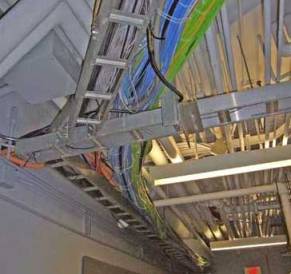Types of electrical cables in industrial premises
Called wires and cables and related fasteners with supporting, protective structures and parts of electrical wiring.
From PUE this definition also applies to electrical wiring of power, lighting and secondary circuits with a voltage of up to 1 kV AC and DC, made inside buildings and structures, on external walls, institutions, enterprises, on construction sites, using insulated wires of all cross-sections, as well as non-armored power cables in a rubber or plastic sheath with a cross-section of the phase wire up to 16 sq. mm.
Electric wires placed on the surface of walls, ceilings, trusses and other construction elements of buildings and structures, supports, etc. are called open.
Electrical wiring laid inside the structural elements of buildings and structures (walls, floors, foundations, ceilings) is called hidden.
Electric wiring laid on the external walls of buildings and structures, as well as between buildings on supports (not more than 4 sections and a length of 25 m on each section) outside streets, roads, etc. are called outside… It can be open and hidden.
A steel wire stretched close to the surface of a wall, ceiling, etc., intended to fasten wires, cables or their bundles to it, is called a string.
A metal strip fixed near the surface of a wall, ceiling, etc., intended for attaching wires, cables or their bundles to it, is called a strip.
A cable (supporting element of electrical wiring) is a wire or steel rope stretched in the air, designed to suspend wires, cables or bundles to it.

A box is a hollow closed structure with a rectangular or other cross-section, intended for laying wires or cables in it.
A tray is called an open structure, designed for laying wires and cables on it. The panel is not a protection against external mechanical damage, wires and cables placed in it.
Electrical wiring of lighting and power networks is carried out with unprotected insulated wires, protected wires and cables.
